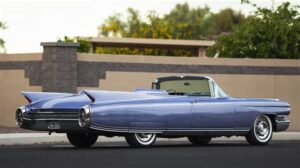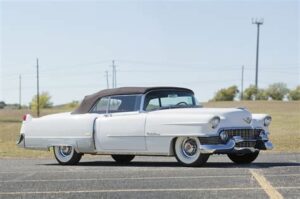When it comes to understanding your vehicle’s emission system, one component stands out: the Cadillac converter. Essential for reducing harmful exhaust emissions, a Cadillac converter plays a pivotal role in ensuring your car meets environmental standards. But what exactly does it look like, and how can you identify its distinct features? In this article, we’ll dive deep into the visual characteristics of a Cadillac converter, including what it looks like under the hood, how to spot one, and the variations that exist among different models. Additionally, we’ll discuss how to recognize if a Cadillac converter has been damaged and provide answers to common questions you may have. Whether you’re a car enthusiast or simply looking to enhance your knowledge, this guide will equip you with the insights you need. Let’s get started!
What Do Cadillac Converters Look Like Under The Hood?
When inspecting your vehicle, the what do Cadillac converters look like under the hood can be quite telling. Generally, Cadillac converters are positioned between the engine and the exhaust system, and their appearance can vary slightly depending on the model and make of the vehicle.
Typically, a Cadillac converter is a metallic, oval-shaped object that is often circular or rounded at one end. The casing is made from stainless steel or a similar durable material designed to withstand high temperatures. You’ll notice that it has a series of flanges or pipe fittings on either end, which connect it to the exhaust pipes. The surface may show signs of discoloration or soot accumulation, which are natural byproducts of the combustion process.
Additionally, the converter may also have labels or stamps indicating its compliance with emissions standards, which is a critical feature for many vehicles, including Cadillacs. If you look closely, you might find a small viewing port or an oxygen sensor attached to the converter, which further aids in monitoring emissions and vehicle performance.
Understanding what do Cadillac converters look like under the hood can help you identify their condition and functioning. A proper inspection can prevent potential issues and contribute to the overall health of your vehicle’s exhaust system.
The Distinct Features Of A Cadillac Converter
When exploring the question of what do Cadillac converters look like, it’s essential to recognize their distinct features. These components are crucial for a vehicle’s emissions system, and they boast several characteristics that make them easily identifiable.
Firstly, a Cadillac converter typically has a cylindrical or oval shape and is made from durable metal. The outer casing is usually constructed from stainless steel, which gives it a shiny appearance. The dimensions may vary depending on the make and model of the vehicle, but a standard converter generally ranges from 12 to 20 inches in length and 5 to 10 inches in diameter.
One notable feature is the presence of a honeycomb structure inside the converter. This structure is responsible for facilitating the chemical reactions necessary to convert harmful gases into less harmful emissions. This honeycomb is often made from precious metals such as platinum, palladium, and rhodium, which are integral to the converter’s function.
Additionally, many Cadillac converters will have identifying markings or numbers stamped on their bodies. These identifiers can include the manufacturer’s name and the converter’s part number, which can assist in confirming its authenticity and compatibility with a specific vehicle.
When considering what do Cadillac converters look like, their cylindrical shape, shiny stainless steel exterior, honeycomb interior, and identifying markings are key features to monitor. Being aware of these attributes can help in both identification and maintenance of these crucial components.
How To Identify A Cadillac Converter Visually
Identifying a Cadillac converter visually can be straightforward if you know what to look for. Here are some key features that can help you determine whether you are looking at a Cadillac converter:
- Shape and Size: Cadillac converters typically have a cylindrical or oval shape and can vary in size depending on the vehicle model. They are designed to fit in the exhaust system, usually located between the engine and the muffler.
- Material: The exterior of a Cadillac converter is usually made from stainless steel or a heat-resistant material. If you see any rust or corrosion, it might indicate age or that it has been damaged.
- Welds and Joints: Examine the connections where the converter attaches to the exhaust pipes. A Cadillac converter will generally have clean welds and may be clamped securely.
- Engravings or Identification Numbers: Some Cadillac converters have stamped numbers or letters on the body indicating specific information about the part, including the make and model. This can be a useful identifier.
- Emissions Designation: Observe any emissions labels or designs located on or near the converter, as these can indicate its compliance with environmental regulations and help in identifying its authenticity.
Remember that while visual identification is a good starting point, consulting a professional or further research may be necessary for accurate identification, particularly if you’re assessing the functionality or condition of the converter.
What Do Cadillac Converters Look Like When Damaged?
When you are diagnosing issues with your vehicle, one of the key components to inspect is the Cadillac converter. A damaged Cadillac converter can significantly affect performance and emissions. Here are some common signs to look out for when determining if a Cadillac converter is damaged:
- Visible Cracks or Breaks: Inspecting the casing can reveal if there are any exterior cracks or breaks which indicate internal failure.
- Discoloration: A Cadillac converter that has become discolored, especially if it appears burnt or oxidized, often suggests overheating and potential damage.
- Broken Hangers: If the converter is loose due to broken hangers or supports, it may shift, leading to further damage.
- Rattling Noises: A rattling sound coming from under the vehicle can suggest that the internal substrate has broken apart.
- Unusual Exhaust Smells: If you notice a strong smell of sulfur or rotten eggs, it could indicate that the Cadillac converter is malfunctioning and not properly converting gases.
- Check Engine Light: Often, a damaged Cadillac converter will trigger the vehicle’s check engine light. Always check the error codes if this occurs.
Identifying these signs early can help you address issues before they become more serious and potentially more costly to repair.
Common Variations: What Do Different Cadillac Converters Look Like?
Cadillac converters can vary significantly in appearance based on several factors, including the model year, engine type, and specific emissions requirements. Understanding these variations can assist in identifying the right replacement part and ensuring optimal vehicle performance. Here are some of the common types of Cadillac converters you might encounter:
- Standard Catalytic Converters: Typically feature a cylindrical or oval shape, these converters are designed for most gas-powered vehicles. They usually have a metallic casing, which can be either stainless steel or aluminized steel.
- High-Performance Catalytic Converters: Often utilized in sport or performance vehicles, these converters are designed with larger cores to maximize exhaust flow. Their appearance may include a more robust construction with thicker walls.
- Diesel Catalytic Converters: These converters are generally larger and bulkier than their gasoline counterparts. They sometimes include additional components such as a Diesel Particulate Filter (DPF) integrated into their design.
- Aftermarket Catalytic Converters: Available for various vehicle models, these converters may differ in appearance and performance from OEM (Original Equipment Manufacturer) parts. They often mimic the design of standard converters but may be labeled differently.
- OEM Catalytic Converters: These are designed specifically for a particular vehicle model and year, hence they weigh and look similar to the original part installed. They often come with unique identifying markings or part numbers for verification.
When assessing what do Cadillac converters look like, it’s essential to consider what type you have, as this will influence both your inspections and potential replacement options. Always refer to your vehicle’s specifications or consult a professional to ensure compatibility.
Frequently Asked Questions
What is a catalytic converter?
A catalytic converter is an emissions control device that reduces harmful gases from an internal combustion engine by converting them into less harmful substances.
What does a typical catalytic converter look like?
A typical catalytic converter resembles a small, cylindrical or oval metal canister, often made of stainless steel, and can be found near the exhaust manifold or along the exhaust pipe.
What materials are catalytic converters usually made from?
Catalytic converters are commonly made from a combination of materials including precious metals like platinum, palladium, and rhodium, along with ceramic or metallic substrates.
How can I identify a catalytic converter in my vehicle?
You can identify a catalytic converter by looking for a metal casing connected to the exhaust system, typically located between the engine and the muffler.
Are there different types of catalytic converters?
Yes, there are different types of catalytic converters, including two-way and three-way converters, each serving specific functions in emissions reduction.
What are the signs of a failing catalytic converter?
Signs of a failing catalytic converter include decreased engine performance, increased exhaust emissions, a sulfur smell, or a check engine light illuminated on the dashboard.
How important is the catalytic converter for vehicle emissions?
The catalytic converter is crucial for vehicle emissions control, as it helps to significantly reduce pollutants that cause smog and environmental damage.





